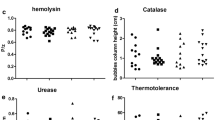Summary
Pathogen, host and environmental factors must be considered in order to understand the pathogenesis of dermatophilosis. A frequently cited sequence of events involves physical damage to the skin, bacterial multiplication in the epidermis, repeated cycles of invasion by hyphae, infiltration by neutrophils and exudate, regeneration of epidermis and reinvasion. This paper is concerned with pathogen driven mechanisms involved in the origin and development ofDermatophilus congolensis infections. Primary infections of calves under controlled conditions at clipped, cleaned, defatted sites result in characteristic dermatophilosis crusts, illustrating thatD. congolensis itself is pathogenic. Calves infected in this way develop protective immune responses to subsequent infections. In contrast first and second infections of calves simultaneously infested withAmblyomma variegatum result in more severe lesions that take significantly longer to heal than lesions on tick free calves. Immunity toD. congolensis is isolate specific, however the antigens that elicit immunity have not been defined, they might include pathogenic or virulence factors. Hyphae are the life-cycle stage most closely associated with the living epidermis. Duringin vitro growth hyphae secrete antigens and proteolytic enzymes into culture medium. Proteolytic activity has been linked to virulence ofD. congolensis. The characteristics of proteases released into culture medium varies between isolates. This raises the possibility that proteases, with as yet undefined functions, act as pathogenic and virulence factors, that they are the targets for protective immune responses and thatA. variegatum infestation interferes with host immune responses that normally inhibit their activity.
Similar content being viewed by others
References
Abu-Samra, M. T. (1979). A study of the ultrastructure and the life-cycle ofDermatophilus congolensis.Zentralblatt für Veterinaermed Riehe,26, 110–124.
El Jack, M. A. &Ambrose, N. (1993). Culture filtrate proteins ofDermatophilus congolensis.Revue d'Elevage et de Médecine Vétérinaire des Pays Tropicaux,46, 257–261.
Ellis, T. M., Masters, A. M., Sutherland, S. S., Carson, J. M. &Gregory, A. R. (1993). Variation in cultural, morphological, biochemical properties of Australian isolates ofDermatophilus congolensis.Veterinary Microbiology,38, 81–102.
Ellis, T. M., Robertson, G. M., Sutherland, S. S. &Gregory, A. R. (1987). Cellular responses in the skin of Merino sheep to repeated inoculation withDermatophilus congolensis.Veterinary Microbiology,15, 151–162.
Ellis, T. M., Sutherland, S. S. &Davies, G. (1991). Strain variation inDermatophilus congolensis demonstrated by cross-protection studies.Veterinary Microbiology,28, 377–383.
Ellis, T. M., Sutherland, S. S. &Gregory, A. R. (1989). Inflammatory cell and immune function in Merino sheep with chronic dermatophilosis.Veterinary Microbiology,21, 79–93.
Gogolewski, R. P., Mackintosh, J. A., Wilson, S. C. &Chin, J. C. (1992). Immunodominant antigens of zoospores ofDermatophilus congolensis.Veterinary Microbiology,32, 305–318.
Hänel, H., Kalisch, J., Keil, M., Marsch, W. C. &Buslau, M. (1991). Quantification of keratinlytic activity fromDermatophilus congolensis.Medical Microbiology and Immunology,180, 45–51.
Hermoso de Mendoza, J., Arenas, A., Alonso, J. M., Rey, J. M., Gil, M. C., Anton, J. M. &Hermoso de Mendoza, M. (1994). Enzymatic activities ofDermatophilus congolensis measured by API ZYM®.Veterinary Microbiology,37, 175–179.
How, S. J. &Lloyd, D. H. (1988). Immunity to experimental dermatophilosis in rabbits and cattle following immunisation with a live whole cell vaccine.Revue d'Élevage et de Médecine Vétérinaire des Pays Tropicaux,41, 139–146.
Koney, E. B. M., Morrow, A. N., Heron, I. D., Ambrose, N. C. &Scott, G. R. (1994). Lymphocyte proliferative responses and the occurrence of dermatophilosis in cattle naturally infested withAmblyomma variegatum.Veterinary Parasitology,55, 245–256.
Kwapinski, J. B. (1966). Serological and chromatographic characterisation of exo-antigens of theDermatophilius.Australian Journal of Experimental Biology and Medical Science,44, 87–92.
Lloyd, C. M. &Walker, A. R. (1993a). The effect of inflammatory and hypersensitive reactions, in response to the feeding of the tickAmblyomma variegatum, on the progression of experimental dermatophilosis infections.Experimental and Applied Acarology,17, 345–356.
Lloyd, C. M. &Walker, A. R. (1993b). The systemic effect of adult and immature Amblyomma variegatum ticks on the pathogenesis of dermatophilosis.Revue d'Elevage et de Médecine Vétérinaire des Pays Tropicaux,46, 313–316.
Martinez, D., Barré, N., Mari, B. &Vidalenc, T. (1992). Studies on the role ofAmblyomma variegatum in the transmission ofDermatophilus congolensis. In:Tick Vector Biology: Medical and Veterinary Aspects. (Eds B. Fivaz, T. Petney and I. Horak). Springer-Verlag, Berlin, pp 87–99.
Oduye, O. O. (1976). The histopathological changes in natural and experimentalDermatophilus congolensis infection of the bovine skin. In:Dermatophilus Infection in Animals and Man. (Eds D. H. Lloyd and K. C. Sellers). Academic Press, London, pp 172–181.
Poermadjaja, B., Ambrose, N., Walker, A. &Morrow, A. (1993). Cellular responses in experimental chronic and acute dermatophilosis infections of sheep.Revue d'Elevage de Médecine Vétérinaire des Pays Tropicaux,46, 227–182.
Rao, C. N., Peavey, C. L., Liu, Y. Y., Lapiere, J.-C. &Wodley, D. T. (1994). Partial characterisation of matrix-associated serine protease inhibitors from human skin cells.Journal of Investigative Dermatology,104, 379–383.
Roberts, D. S. (1961). The life-cycle ofDermatophilus dermatonomus the causal agent of ovine mycotic dermatitis.Australian Journal of Experimental Biology and Medical Science,39, 463–476.
Sondell, B., Thornell, L.-E. &Egulrud, T. (1994). Evidence that stratum corneum chymotryptic enzyme is transported to the stratum corneum extracellular spacevia lamellar bodies.Journal of Investigative Dermatology,104, 819–823.
Tamai, K., Ishikawa, H., Mauviel, A. &Uitto, J. (1995). Interferon- γ co-ordinately upregulates matrix metalloproteases (MMP)-1 and MMP-3, but not tissue inhibitor of metalloproteases (TIMP), expression in cultured keratinocytes.Journal of Investigative Dermatology,104, 384–390.
Trott, D. J., Masters, A. M., Carson, J. M., Ellis, T. M. &Hampson D. J. (1995). Genetic analysis ofDermatophilus spp. using multilocus enzyme electrophoresis.Zentralblatt für Bakteriologie,282, 24–34.
Walker, A. R. &Lloyd, C. M. (1993). Experiments on the relationship between feeding of the tickAmblyomma variegatum (Acari: Ixodidae) and dermatophilosis skin disease in sheep.Journal of Medical Entomology,30, 136–143.
Zaria, L. T. (1993).Dermatophilus congolensis infection (dermatophilosis) in animals and man! An update.Comparative Microbiology and Immunology of Infectious Diseases,16, 179–222.
Author information
Authors and Affiliations
Rights and permissions
About this article
Cite this article
Ambrose, N.C. The pathogenesis of dermatophilosis. Trop Anim Health Prod 28 (Suppl 2), 29S–37S (1996). https://doi.org/10.1007/BF02310696
Issue Date:
DOI: https://doi.org/10.1007/BF02310696




